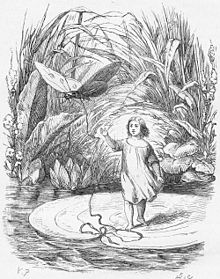Thumbelina
Thumbelina ( Danish Tommelise ) is an art fairy tale by Hans Christian Andersen , which was first published in 1835.
action
A woman wants a child and asks an old witch for help. She receives a magical stye from her , which she plants in a flower pot. From it grows a flower, in the blossom of which there is a little girl who is no longer than a thumb and is therefore called Thumbelina.
One night, Thumbelina is sleeping in her walnut-shell bed, an old toad jumps into the room and kidnaps Thumbelina onto a lake, because the toad sees Thumbelina as a suitable bride for her stupid and ugly toad son. Friendly fish gnaw away the lily pad on which Thumbelina is caught.
So it floats on the leaf into freedom, pulled by a butterfly. A cockchafer falls in love with Thumbelina on the way, but when the other cockchafer call Thumbelina ugly, he drops her. Winter is coming and Thumbelina is starving and freezing. In her distress, she asks for shelter with an old field mouse , which she graciously welcomes. For food and lodging, Thumbelina has to keep the field mouse's house clean and tell her stories in order to drive away the long winter evenings. Thumbelina finds a half-frozen swallow and nurses it back to health. The neighbor, a rich and naturally blind mole , often comes to visit and finally asks for Thumbelina’s hand. Thumbelina flees to a warm land on the swallow's back.
There she finds a winged Prince Charming of her size in a flower bed, whom she marries. Her husband gives her a pair of wings and gives her a new name: Maja. Now both can fly from flower to flower.
role models
The story of Thumbelina is not an adaptation, but essentially created by Andersen. Nevertheless, literary models can be identified: the most important influence is the traditional fairy tale of the Thumbnail , which also places a miniature person at the beginning of the story as a supernatural fulfillment of a wish to have children. Other inspirations are Swift's Lilliputians in Gulliver's Travels (1726), Voltaire's story Micromégas with its giant and dwarf people (1752) and the story of Meister Floh by ETA Hoffmann (1822). Also by ETA Hoffmann is the story of Princess Brambilla (1821), in which a small creature lives in a flower. In Andersen's own tale, Foot Trip from Holmen's Canal to the Eastern Point of Amage (1828), a tiny girl appears.
Film adaptations
- “Däumelienchen” by Lotte Reiniger , silhouette film , 1954, duration: 10 minutes.
bibliography
- Hans Christian Andersen: Thumbelina , edited by Sonja Hartl with pictures by Lisbeth Zwerger . Neugebauer Verlag, Zurich 1987. ISBN 3-314-01616-6
- Hans Christian Andersen: Thumbelina , German by Quentin Gréban, edited by Katrin Hoffmann. Coppenrath, Münster 2007, ISBN 3-8157-7966-9 .
- Hans Christian Andersen: Thumbelina . Classic for first-time readers, edited by Ilse Bintig with pictures by Uli Waas . Ed. Bücherbär, Würzburg 2007. ISBN 3-401-08928-5
Web links
- Thumbelina at Zeno.org .
- HC Andersen: Tommelise - original text on the website of the Danish Royal Library (Danish)
Individual evidence
- ^ Eventyr, continue for Børn . Første Samling. Andet booklets. 1835. Fairy tales told for children. New collection. Second issue. CA Reitzel: Copenhagen 1835.
- ^ A b Jackie Wullschläger : Hans Christian Andersen: The Life of a Storyteller . University of Chicago Press, Chicago 2002, ISBN 0-226-91747-9 , p. 162.
- ^ Youtube , Internet Movie Database (IMDb) .
